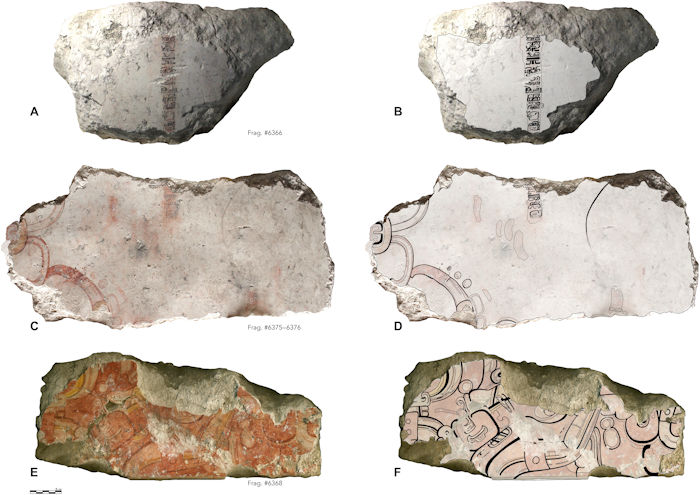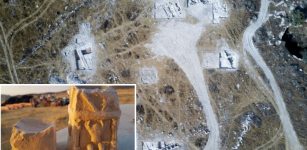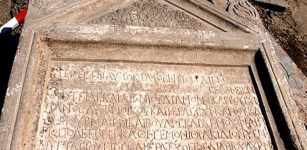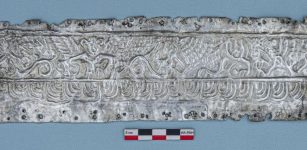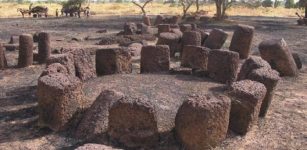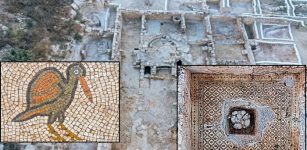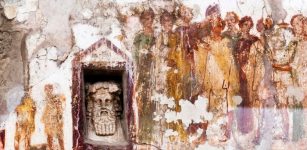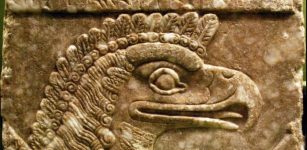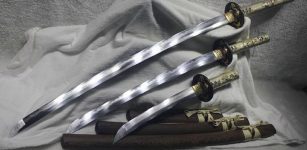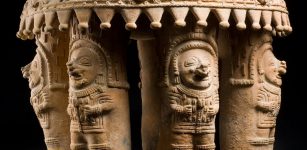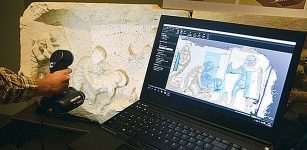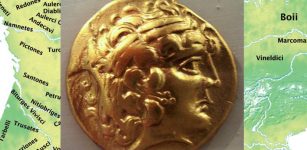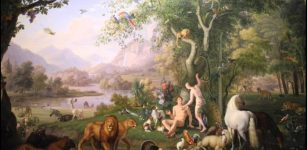Earliest Evidence Of A 260-Day Maya Calendar Found Inside Guatemalan Pyramid
Jan Bartek - AncientPages.com - While excavating in Guatemala archaeologists discovered a glyph representing a day called "7 Deer" on mural fragments dating from the third century B.C found inside the ruins of Las Pinturas pyramid.
In a new study scientists present evidence the painting mural is the earliest known calendar notation from the Maya region.
Reconstruction view of the San Bartolo Sub-V phase architecture (300 to 200 BCE) showing radial structure, miniature ballcourt, and elongated platform referred to as structure Ixbalamque that together form an E-group. Drawing by Heather Hurst. Inset: Example of two mural fragments (consolidated as #4778), the 7 Deer day-sign and partial hieroglyphic text, among a total of 249 fragments of painted plaster and painted masonry blocks collected during archaeological excavations of the Ixbalamque context. Photograph by Karl Taube, courtesy of the Proyecto Regional Arqueológico San Bartolo-Xultun.
“We assign these fragments to between 300 and 200 BCE, preceding the other well-known mural chamber of San Bartolo by approximately 150 years. The date record “7 Deer” represents a day in the 260-day divinatory calendar used throughout Mesoamerica and among indigenous Maya communities today.
It is presented along with 10 other text fragments that reveal an established writing tradition, multiple scribal hands, and murals combining texts with images from an early ritual complex. The 7 Deer day record represents the earliest securely dated example of the Maya calendar and is important to understanding the development of the 260-day count and associated aspects of Mesoamerican religion and cosmological science,” the researchers write in their study published in the journal Science Advances.
“The Las Pinturas pyramid complex is located at the geographic center of the small Late Preclassic site of San Bartolo. In its final construction phase, a large pyramid (Structure 1) dominated the east side of a raised platform shared with two smaller buildings on the north and south in a triadic arrangement facing west; a fourth structure closed the temple patio on the west side located at the top of the stairway accessing the complex. The final phase of Structure 1 dates to the first century CE, with monumental construction ceasing throughout San Bartolo by 150 to 250 CE (3). Archaeological excavations in the Pinturas complex revealed a total of seven major constructions phases that span 400 BCE to 100 CE; many of these phases, like its final construction, were composed of multiple buildings defining a ritual complex. In general, each new construction completely covered the earlier construction within its foundation,” the researchers explain in the study.
The Maya often built what initially were modest-sized temples, then constructed ever-larger versions atop the earlier ones. Las Pinturas pyramid eventually reached about 100 feet (30 meters) tall.
According to University of Texas professor of Mesoamerican art and writing David Stuart, lead author of the research, the unearthed mural fragments were like “two small pieces of white plaster that would fit in your hand, that were once attached to a stone wall”.
"The wall was intentionally destroyed by the ancient Maya when they were rebuilding their ceremonial spaces - it eventually grew into a pyramid. The two pieces fit together and have black painted calligraphy, opening with the date '7 Deer.' The rest is hard to read," Stuart added.
"The paintings from this phase are all badly fragmented, unlike any from the later, more famous chamber," Stuart said.
“The 260-day count is the traditional divination calendar used throughout ancient Mesoamerica, surviving up to the present among some indigenous communities in southern Mexico and Guatemala. Designations for individual days involve two elements: a number from 1 to 13 combined with 1 of 20 named days in a set order,” researchers say.
The ancient calendar 260-day Maya calendar, called the tzolk'in was based upon observations of the movements of the sun, moon, and planets. It was also one of several inter-related Maya systems of reckoning time, also including a solar year of 365 days, a larger system called the "Long Count" and a lunar system.
In the system used by the Mexica (Aztecs) of the 16th century, the day 7 Deer (7 Mazatl) would be followed by 8 Rabbit, 9 Water, 10 Dog, 11 Monkey, 12 Grass, and so on. The meanings were often similar across languages, forging a calendar system that came to be an elemental factor in the definition of “Mesoamerica” as a cultural region,” the scientists write in their study.

Detail of fragment #4778 collected from the Sub-V phase (~300 to 200 BCE), with the 7 Deer day sign. Consolidated mural fragment #4778 in black-line style, collected from the Ixbalamque structure: (A) the digital scan and (B) the illustration depicting the 7 Deer day sign and two hieroglyphic signs in a vertical column. Scans by Heather Hurst and illustration by David Stuart.
Until now, the earliest definitive Maya calendar notation dated to the first century B.C. But this latest discovery changes scientists understanding of the timeframe.
In this context, it is also worth noting that the deer glyph is special because, during the Classic period, Maya scribes only rarely used the deer’s head as the glyph for the seventh day. Instead, it was far more common to use a hand sign, showing the thumb and forefinger touching.
“We emphasize that the key point that San Bartolo mural fragment #4778 is a very rare example of a clear hieroglyphic date from the Late Preclassic period. Only a handful of date records from this time frame are known in the Mesoamerican archaeological record, with many of them difficult to date with any precision,” the researchers conclude in their paper.
See also: More Archaeology News
According to radiocarbon analysis, the recent finding is a very rare example of a clear hieroglyphic day of the year, which was written sometime between 200 and 300 B.C.
The study was published in the journal Science Advances.
Article in Portuguese - here
Written by Jan Bartek - AncientPages.com Staff Writer


